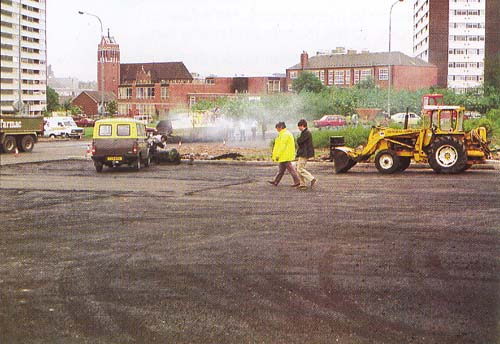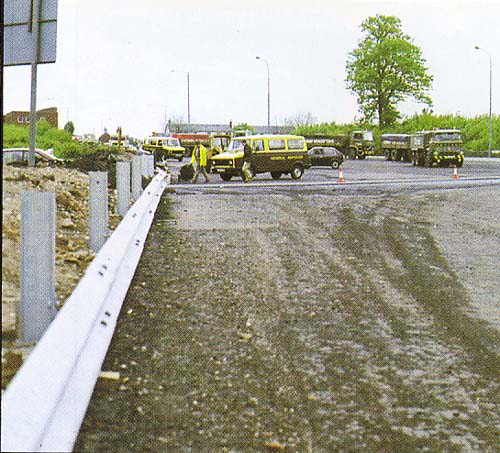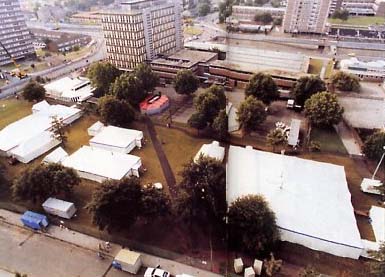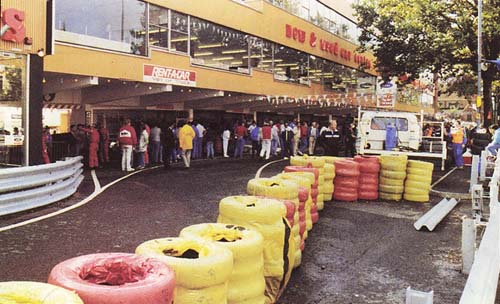Birmingham Superprix - Britain's most controversial circuit?
1986 - Politics turns ugly as the big day approaches
Author
- David Page
Date
- February 19, 2007
Back to BSP index page
There was a lot of excitement ahead of the inaugural Birmingham Superprix but there was a lot still to be done too, such as work on the circuit and putting together a race programme for the August Bank holiday weekend.
On Monday 17th March, John Webb and his company, Motor Circuit Developments, who control other British circuits such as Brands Hatch, Oulton Park and Snetterton signed an exclusive three-year contract with the Birmingham City Council to help stage the Birmingham Superprix. John Webb, widely regarded as “Mr. Motor Racing” in Britain, had proved that big business and motor racing mix, attracting an increasing amount of business sponsorship to the sport and to the city of Birmingham. Also his company “will advertise and offer guidance to the council in all matters concerning or affecting motor racing.”
Mrs Marjorie Brown, Chairman of the Road Race sub-committee was quoted: “It is this professionalism and expertise in motor racing that the city of Birmingham wanted to ensure the best possible team was organising out first racing on the streets.”
On signing his contract with the City Council, John Webb said: “Normally, a circuit has to start with an amateur meeting – Birmingham has gone ten times better. It has started off with the most professional team it is possible to assemble in this country.”
Gary Newbon, Central TV’s Head of Sport also announced that the F3000 race would be televised by Central Television in live programmes, with national and international spin-off. This would be plenty of magnificent exposure for the city and the sponsors of the Birmingham Superprix.
After losing out the bid for his very own idea, and as a consolation for Martin Hone, he was given a budget of £70,000 to run similar parades with cars and champions at all expenses covered like he did in the past with his On The Streets events. The budget was to organise a grand dinner, ball and a 45-minute parade during the two-day August Bank holiday event. But his 1984 Chequer Bitter parade cost him £166,000 and he wasn’t willing to lower his standards, as he couldn’t get it under £110,00,0 so naturally he declined the City Council’s offer, whereupon they issued a press release to the tune of “Martin Hone turns down £70,000 cash offer to run parades.”
The media gave it enormous coverage in April that continued on and off for some time. There were other newspaper headlines such as:
“ROAD RACE PLAN ROCKED BY ROW OVER CONTRACTS”
“ROAD RACE DREAM THAT IS NOW A NIGHTMARE” and
“ROAD RACE GAG ON HONE IS DENIED.”
The last headline refers to the contract that the City Council offered to Martin Hone. He referred to it as the ‘crumbs’ and claimed it contained two clauses that he refused to accept – one of them would bind him to not to complain to the media and the other saying he had no rights to the race. The contract was only worth £3,200 to his company. He admitted he was willing to sign it if it wasn’t for the clauses.
It was common knowledge around the City that there was some antagonism between himself and some City Councillors who felt that he would want to take some personal credit for any success that the road race might achieve. One un-named councillor was quoted as saying: “It won’t be the Martin Hone show.”
Martin Hone himself explained his point that it was all down to his sheer enthusiasm and energy that resulted in banging tables and upsetting a few people in the early years. He argued that it was his company had developed the idea and that he had fought for 19 years to bring international racing to the streets of Birmingham and now he felt he had been squeezed out.
A Motor Sport magazine article about the Birmingham Superprix published in 2002 summed up perfectly: “The man you have to feel sorry the most is Hone, whose baby was snatched away from him at birth.”
He insisted that the City had lost thousands of pounds and wasn’t supporting the West Midlands firms enough. He said that he had far better deals set up to buy the race and to sell the television rights than those made later by the City. He disapproved the fact that the London firms got the contracts and rights to have the video film rights, catering, ticket selling and road race sponsorships.
The City Council counter-argued, as the Road Race Committee chairman, Majorie Brown said that they had signed many contracts with West Midlands based firms and Martin Hone’s company had failed to meet the City Council’s requirements in their tender for the sponsorship contract.
But there was plenty of positive news as the ticket sales office at the Birmingham City Council opened on 28th April and reported a ‘phenomenal’ response with more than 300 seats sold in the first few hours. Bookings had been pouring in from all over Britain such as coach companies based in Wales and Scotland to make arrangements to bring race fans to the race.
The city council issued a press release on 3rd July of the final race programme for the 24th and 25th August. The timetable would look like this:
Sunday
| 0900-0945 | F3000 | Untimed Group A practice session |
| 1000-1045 | F3000 | Untimed Group B practice session |
| 1100-1140 | Thundersports | Heat 1 qualifying session |
| 1200-1240 | Thundersports | Heat 2 qualifying session |
| 1300-1345 | F3000 | Group A first qualifying session |
| 1400-1445 | F3000 | Group B first qualifying session |
| 1500-1530 | F3000 | Group A second qualifying session |
| 1545-1615 | F3000 | Group B second qualifying session |
| 1645 Race 1 | Thundersports | Heat 1-10 laps |
| 1715 Race 2 | Thundersports | Heat 2-10 laps |
Monday
| 0900-0940 | Pro-Am Renault | Untimed practice session |
| 1000-1020 | F3000 | Warm-up |
| 1035-1100 | FF1600 | Untimed practice session |
| 1100 | F3000 drivers’ briefing | |
| 1120-1155 | Formula Libre | Untimed practice session |
| 1215 Race 3 | Pro-Am Renault | 2 x 5 laps |
| 1300 Race 4 | Thundersports | Trophy Race 30 laps |
| 1400 | F3000 pitlane open | |
| 1420 | Countdown to the F3000 race | |
| 1435 Race 5 | The Halfords Birmingham Superprix | 52 laps |
| 1635 Race 6 | FF1600 | 10 laps |
| 1715 Race 7 | Formula Libre | 15 laps |
As Birmingham will be introducing a first of motor racing in the streets of mainland Britain, they made an other first as they decided to make a way to attracting sponsorship by allowing sponsors to name certain corners and straights of the Birmingham Superprix circuit.
The Birmingham City council issued a press released on 18th July, they announced that the City council has recognised the “diligent and patient work to establish street racing in Birmingham’s city centre” to Cllr Peter Barwell.
Cllr John Charlton, Chairman of the Road Race sub-committee unanimously determined to name a hill on the circuit after Peter Barwell who first mooted the idea to then Town Clerk 18 years ago when he was a recently elected back-bench councillor.
There was a omission as there is still no mention of Martin Hone or of anything that the city council would have done anything of him. Peter Barwell commented on what it feels like to become a name of a part of the Birmingham Superprix circuit:
“Sometimes it has felt like an uphill struggle. But I and my colleagues have always known this could, should and would work for the city and the people of Birmingham. I am delighted to have played a part in bringing the glamour of Monaco, Brands Hatch and other major racing circuits to this great city of Birmingham.”
The city council decided to do a dress rehearsal one month before the race. It was the official course test for the Halfords Birmingham Superprix to be held over the weekend of 24th and 25th August. Only four drivers with their cars were invited for the dress rehearsal. They were Tony Trimmer with his five-litre 550bhp Formula 5000 Lola T330, Roger Orgee with his F2 Lyncar, Mike Wilds with a five-litre Chevrolet Thundersports car and John Brindley with his Ford Cosworth-engined Sierra XR4Ti.
The official track test was on Sunday 27th July. Many citizens of Birmingham were thrilled by the city’s first spectacle of racing cars on roads normally set with a 30mph speed limit were out behind the track-side barriers soon after 6 am to get fleeting glimpses of the four test cars flashing by. It was an enthusiasm not shared by some disgruntled residents jolted from sleep.
The first comments by former Formula One driver, Tony Trimmer were: “This is really exciting. It is a true driver’s circuit. I love it.”
He was later asked when he stepped out of his Lola: “This is a circuit that is going to sort the men from the boys. It need precision driving, is certainly going to be very hard on the brakes – much more impressive than I had ever hoped. It is terrific.”
He lapped around the 2.4-mile circuit with an average speed of 97mph (1 minute 40 seconds). The F3000 cars should be about 10 seconds, perhaps more quicker than what Trimmer claimed, as he had to slow down at sections that required cautious handling in places where the barriers had not yet been installed.
All of the drivers that took part at the half-hour long track test agreed that in August, Birmingham could expect to see cars lapping the circuit at an average of 130mph, touching 185mph along Sherlock and Belgrave Middleway. Also they generally agreed that the track surface was good and smooth, although ripples in braking points should make for some excitement.
It was a dress rehearsal not just for the cars to test out the new street circuit. It was prospect that gave significance to the track test of emergency services planning by senior police, fire and ambulance personnel. The Fire Service took a video recording of the circuit and would be extensively studied by fire and police services.
Assistant Chief Fire Officer Rex Martin said that a fire station would be maintained within the circuit area, with a number of other appliances strategically placed around the area. Assistant Chief Constable Paul Leopold said that the track test will be fully assessed and he felt there would no reason that the policing of the first Birmingham Superprix would impose any problem for the police force.
After the track test, the only alternations of the circuit requested by the drivers involved removal of kerbs near an adverse camber at Highgate which would be the Halfords Corner.
Andrew Ratcliffe, team manager of the Thundersports car featured at the track test, said that the street race would be faster than Monaco and more exciting that Long Beach.
As the race organisers followed the drivers’ recommendations to improve the circuit and they continue to improve the track surfaces and putting up grandstands.
Every day for nearly a year, 30-40 workmen from the City Engineer’s Department under the Chairmanship of Councillor Bill Turner have been resurfacing the roads:

Erecting 8 miles of Armco barriers around the circuit:

Constructing run-off areas, preparing areas for the stands and putting up marquees for the VIPs:

Building the paddock area in the wholesale market near Pershore Street and preparing the Bristol Street Motors area for the pits:


The date of Sunday 24th August was getting closer and more people were getting more enthusiastic by the day.
